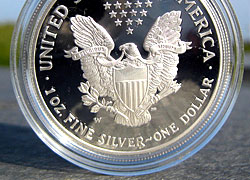
Bullion is a mass of any one of the known precious metals. By strict definition, precious metals are those metallic elements that are rare. Bullion is commonly made of either gold or silver. Its value is determined by the worth of the metal rather than by its face value as money. To put it another way, bullion is valued based on the mass and purity of the metal used, instead of its artificial currency value.
New sources of ore have been discovered and there also have been improvements in the mining and refining processes. These two factors may cause the values of gold, silver, and the other precious metals to diminish. Also, the "precious" qualification of a metal is determined by the market value or high demand.
Bullion is traded on commodity markets in two forms: bulk ingots or coins, the latter minted by the government of a country. At least ten countries are known to mint gold and silver bullion coins. These are Australia, Austria, Canada, China, Mexico, Poland, South Africa, Switzerland, the United Kingdom, and the United States.
While bullion coins are issued as legal tender, with nominal values assigned to them on minting, such face values are far below the commodity value of the metals themselves. Here's an example: Most of the gold coins issued by national governments, particularly those with currency values of between 10 and 100 U.S. dollars, usually contain no less than 31 grams of gold. On the average (considering the consistent rise in the exchange rate of gold), the value of gold is around USD12 per gram. Here, it is clear that the currency value assigned by the government to a gold bullion coin has no meaning.
Below is a list of some of the government-issued gold and silver bullion coins:
1. Australian Gold Nugget, Lunar Series I, and Lunar Series II
2. Austrian Philharmoniker
3. Canadian Maple Leaf
4. Chinese Gold Panda
5. Mexican Centenario, Libertad, and Onza
6. Polish Orzel bielik
7. South African Krugerrand
8. Swiss Vreneli
9. British Britannia and Sovereign
10. American Buffalo, American Eagle, and Double Eagle
The 10,000-dollar Australian Gold Nugget is one of the world's largest bullion coins. Minted by the Australian government, this bullion coin is made of 1 kilogram of 99.9% pure gold. Some other bullion coins larger than the Australian Gold Nugget have come out. However, these are not produced in mass quantities and are not practical to handle. Two examples are given here: One is the 100,000-euro Vienna Philharmonic, minted in 2004, which contains 31 kilograms of gold; the other is the 1 million-dollar Canadian Maple Leaf, minted in 2007, which contains 100 kilograms of gold.
Three factors - metal, purity, and weight - affect the value of bullion. The overall value of bullion is determined by the metal used. We know, of course, that platinum is worth more than gold, which, in turn, is worth more than silver. It is easy to understand, therefore, that silver bullion coins have become popular with collectors because of their relative affordability. You can find even more detailed information about precious metals from Hubpages.
No comments:
Post a Comment